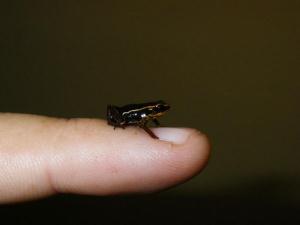
According to the Guinness Book of Records, the record holder for the smallest frog in the world is the Monte Iberia frog from Cuba, scientifically named Eleutherodactylus iberia. Researchers have now discovered that this species contains skin toxins of the alkaloid class of compounds (pumiliotoxins und indolizidines) which probably constitute a fefence mechanism against predators. This fascinating discovery is being published by a team of Cuban and German researchers led by Miguel Vences of the Technische Universität Braunschweig in Germany in the journal "Biology Letters".
Altogether, over 6,000 frog species are known worldwide, but the vast majority of them do not skin alkaloids. These substances so far were only known in four groups of frogs, among them the famous poison-dart frogs of South America. As far as known, alkaloids are not produced by the frogs themselves but are taken up with the food and then sequestered into the skin. The discovery of these substances in the Monte Iberia frogs is the first such record from the genus Eleutherodactylus which contains almost 200 species.
The new discovery provides evidence that the Monte Iberia frogs have evolved the capability to sequester alkaloids independently from other alkaloid-containing groups of frogs. Why has this unlikely event occurred particularly in these frogs? The study indicates that the key might be their small size: They feed on extremely tiny mites and ants which are known to contain alkaloids, and which are often simply overlooked as prey by larger frogs. The poison dwarfs of the Caribbean thus might be poisonous just because they are so small.
Among the almost 6,000 species of frogs that inhabit the Earth, several qualify as veritable dwarfs: In Brazil, Madagascar and Cuba there are species in which the males attain body sizes of only 10 mm or less. Scientifically, they are named Brachycephalus didactylus (Brazil), Stumpffia pygmaea and Stumpffia tridactyla (Madagascar), and Eleutherodactylus iberia (Cuba). A further dwarf frog, the recently discovered Microhyla nepenticola from Indonesia, measures between 10 and 13 mm. But the official record of smallest frog in the world is currently granted to Eleutherodactylus iberia where also females, as far as known, measure less than 11 mm.
The tiny size of these amphibians leads to numerous scientific questions: Which factors have influenced the evolution of their normal-sized ancestors to give rise to these miniaturized animals? Are they specialized to feed on particular prey? And: Which is the reason for the apparently universal size limit at around 10 mm for adult frogs, with no species of vertebrate known to undergo even more drastic miniaturization? These questions are example for the wide potential of studies on miniaturization, in the fields of ecology, developmental biology and evolutionary biology.
Miguel Vences, Professor for Evolutionary Biology at the Technische Universität Braunschweig in Germany, already participated in 1991 in the discovery of the miniaturized Stumpffia pygmaea from Madagascar. In a new research program, a team of Cuban and German researchers led by Vences now examined more in detail the Cuban record holder, Eleutherodactylus iberia in the rainforests of the Alexander-von-Humboldt National Park in eastern Cuba.
"To find these tiny amphibians, one has to examine leaf by leaf the litter on the soil of the rainforest, ending up with tremendous backache." Vences describes the labor-intensive search method.
The intensive searches showed that the dwarf frogs occurred in enormous densities at some sites but were absent elsewhere. The animals were active during the day and had a conspicuous coloration, with strongly contrasting yellow lines on their dark brown body.
"Such a contrsating coloration usually is found in poisonous animals which use it to deter oitential predators" explains Ariel Rodriguez of the Instituto de Ecologia y Sistematica at Havana, first author of the now published study.
Sophisticated chemical analysis methods eventually delivered the evidence: In fact, the Cuban dwarf frogs contain toxins. Several substances of the compound class of the alkaloids were found in their skins.
"This was a very surprising finding because such compounds have so far only been found in four other frog lineages, among them the famous poison-dwarf frogs of South America", states Stefan Schulz, Professor of Organic Chemistry at the Technische Universität Braunschweig who carried out the compound identification. His student Dennis Poth adds: "And, as far as known, the alkaloids are uptaken from the frog's prey".
Finally, prey analyses confirmed also this assumption. The Cuban dwarf frogs apparently mainly feed on particularly small mites and ants which are known to contain alkaloids.
Miniaturization therefore has probably been the key in the evolution of these animals, allowing them to specialize on small, alkaloid-containing prey and to accumulate these toxins in their skin. Once they became toxins, these "Poison dwarfs of the Caribbean" eventually evolved diurnal activity and their contrasting coloration.
The Monte Iberia frog is so far only known from the area of the World Heritage Site "Alejandro de Humboldt National Park" in eastern Cuba where also one of the last sightings of the famous ivory-billed woodpecker have been made. Because of this restricted distribution, Eleutherodactylus iberia is considered to be Critically Endangered by extinction. Cuba has the richest fauna and flora in the West Indies. Compared to several other islands in the Caribbean, forests and other ecosystems in Cuba are quite well preserved, and continued conservation and research efforts are needed to save the Monte Iberia frog and other Caribbean jewels from extinction.
Further Information:
Ariel Rodriguez, Dennis Poth, Stefan Schulz, and Miguel Vences:
Discovery of skin alkaloids in a miniaturized eleutherodactylid frog from Cuba.
In: Biology Letters; published online November 3, 2010, DOI 10.1098/rsbl.2010.0844
Quelle: Technische Universität Carolo-Wilhelmina zu Braunschweig, Technical University, Germany
Last update: 03.11.2010
Perma link: https://www.internetchemistry.com/news/2010/nov10/alkaloid-storing-dwarf-frogs.php
More chemistry: index | chemicals | lab equipment | job vacancies | sitemap
Internetchemistry: home | about | contact | imprint | privacy
© 1996 - 2023 Internetchemistry
